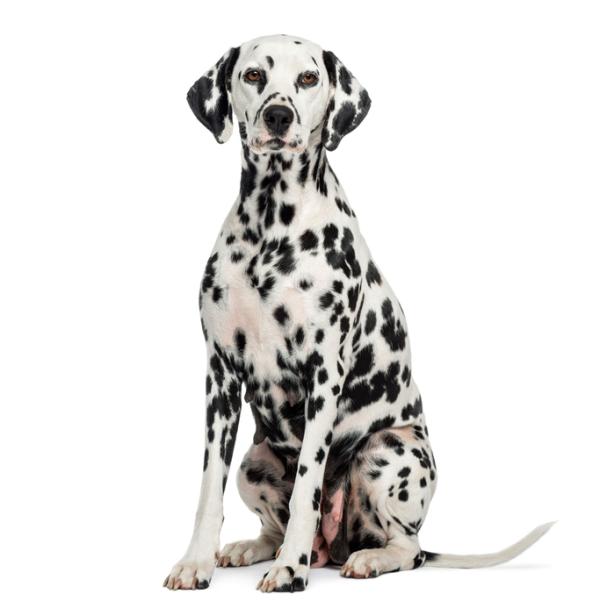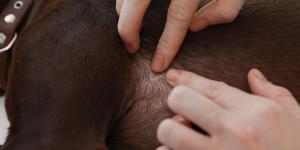Dalmatian

The Dalmatian is one of the most popular dog breeds, known for their peculiar black (or brown) spots on their white coat. This is a very loyal dog, with a stable and calm character, provided they can get enough exercise to release the accumulated tension.
Whether you're thinking of adopting a Dalmatian puppy dog or an adult, in this AnimalWised breed file we'll explain everything you need to know about their character, the main characteristics of the breed, their education and some of the most important health problems. Everything you need to know is listed below.
- Europe
- Croatia
- Group VI
- 5-14
- 14-18
- 18-22
- 22-27
- 27-31
- More than 31
- 2-7
- 7-22
- 22-55
- 55-100
- 100-220
- 8-10
- 10-12
- 12-14
- 15-20
- Low
- Meidum
- High
History of the Dalmatian
Despite being a very well-known breed for a long time, the ancient history and origins of the Dalmatian are really unknown. The first images of Dalmatians are of Croatian paintings and frescoes dating from the 17th century. This is the main reason why the International Cinological Federation (ICF) assigns the origin of the breed to the Croatian region of Dalmatia, but there are different hypotheses that suggest that this dog would have originated much earlier elsewhere.
In any case, the Dalmatian spread throughout the world. Throughout their existence, they performed a multitude of functions. They were employed as a hunting dog, companion dog, guard dog, etc. However, their consecration as "coachman dog" for the English upper class occurred in the late seventeenth century. At that time the noble and wealthy British made a pack of Dalmatians accompany their carriages to show their power. This was supposed to fulfill a dual function: to protect the horses from stray dogs and to provide a more aesthetic view of the carriage.
With the invention of the automobile, driver dogs disappeared and the popularity of the breed fell. However, Dalmatians also accompanied fire engines and that tradition continued. Today they are still part of the fire brigade in many parts of the world, although they now travel on the vehicle.
The popularity of the breed reappeared in the 1960s thanks to the Disney movie "101 Dalmatians" and later had a new boost with the second version of the film. Unfortunately, this ended up hurting the breed, as the old coachman dog became a popular and sought after dog, so they began to breed indiscriminately. The result was overpopulation of the breed and many hereditary diseases due to high inbreeding. Today the Dalmatian is a very popular companion and family dog.
Physical traits of the Dalmatian
This is a beautiful, elegant and distinguished breed with a particularly mottled white coat. The head is proportionate and harmonious with the rest of the body, wrinkle-free and prismatic in shape. Their n aso-frontal depression (stop) is moderately defined. The nose should be the same color as the body's spots. The eyes are oval and their color also corresponds to that of the spots. The ears are of high insertion, triangular, with rounded edges, hanging and mottled.
The body is rectangular, being a little longer than the height at the withers. The back is powerful and straight, while the back is short and the croup is slightly sloping. The chest is deep and not too wide. The belly is moderately gathered, but not sunken. The tail is long, sabre-shaped and is preferred mottled. The coat is short, shiny, hard and dense. It is white mottled with black spots or brown spots.
The Dalmatian's character
The Dalmatian is a friendly, self-confident and very active dog. They usually love to swim, run, and exercise following traces and their own curiosity. They usually get along well with other dogs and other animals. They are also generally friendly with strangers, although they are not as sociable as the Labrador retriever or Golden Retriever. Some, however, are reserved with strangers, but innate aggressiveness is a very rare characteristic of the breed.
They are perfect for active families who exercise with their dogs and want a faithful and energetic companion at their side. However, inside the house the Dalmatian is a calm and serene dog, which is able to relax without any problem.
These dogs are perfectly tolerant of children who know how to respect and care for them as they deserve, but do not always reacts well to tugging tails or ears. This is also why it will be important to teach our children how to play with the Dalmatian in an appropriate way: always with respect and affection. The education of the dog will obviously be very important to achieve a more affable, relaxed and tolerant character. We will inform you about this later.
Dalmatian specific care
The care of the Dalmatian’s fur is really simple: it will need to be brushed very occasionally to remove dead and should only be bathed when their fur is really dirty.
What we really need to pay attention to is the exercise this dog needs. It is essential to be clear about this point if we want to adopt a Dalmatian dog because if it is not fulfilled, it can become somewhat destructive inside the home. Their energy needs are really high so we must take a minimum of three medium-long walks each day and give them at least one hour of active exercise. You can also help us release their accumulated stress by playing intelligence games that, in addition to entertaining our dog, will mentally stimulate them to further develop their excellent abilities.
Finally, we will comment that the Dalmatian, despite being a little independent in some occasions, is a dog that loves to feel part of a social group and deeply detests loneliness. Spending too much time alone can cause behavioral problems such as separation anxiety, just like lack of exercise will.
Dalmatian education
The Dalmatian ranks 39th on Stanley Coren's intelligence scale. However, although many handlers consider him a stubborn dog, they have a natural predisposition to learn when using positive reinforcement. They are tireless and active dogs so, in addition to exercising with them, training will be very useful to improve their well-being and mental health.
We will start with the education of the puppy when they are about 3 months old. It is then when we will begin with the socialization of the puppy during their first walks by introducing them to people, animals and the environment in which they are going to live in. This process is one of the most important in dog education as it will have a direct impact on the habit of social and stable behaviors, far from the fear and aggressiveness that a lack of socialization can cause. Later and in this same period we will also teach the dog how to inhibit their bite, how to play with us or teach them to do their business on the street. We must not forget that in order for the puppy to be able to go out on the street, they must have all their vaccinations up to date.
Later on we will begin to teach them the basic orders of obedience, a very important point for their safety and to foster good communication with us. At this point we will stress the importance of the use of positive reinforcement as punishments and fights are detrimental to learning and can result in unwanted behavior.
Once the Dalmatian has learned the orders we can initiate them in advanced training, in the practice of fun tricks or in advanced activities as it is the case of agility, a circuit of obstacles that mixes exercise and fulfillment of orders of obedience. Agility is undoubtedly a sport suitable for this very active breed.
Taking time to educate your dog is very important, but it's also important to remind them of their orders on a regular basis so that they don't forget them. The average daily time for training is between 5 and 10 minutes.
Dalmatian health
The Dalmatian is a dog prone to many diseases due to inbreeding to which this breed has been subjected for so many years. The most common diseases in the Dalmatian are:
- Allergic dermatitis
- Atopic Dermatitis
- Fungal infections
- Food allergies
- Hypothyroidism
- Demodicosis
- Skin tumors
- Kidney stones
- Urethral stones
- Cardiomyopathies
- Deafness
Deafness has a very high incidence in the breed, and affects more than 10% of Dalmatian dogs. Kidney and urethral stones are very common in the breed because the Dalmatian is the only mammal that cannot metabolize uric acid in allantoin. This directly affects the formation of stones in the urinary tract.
To maintain our dog’s optimal health condition it will be useful to visit the specialist every 6 months to ensure that everything is going well and follow their vaccination schedule strictly. A good diet, exercise and good care will be the key to enjoying a happy, healthy and long-lived Dalmatian.
Vídeo de Dalmatian
Dalmatian photos































